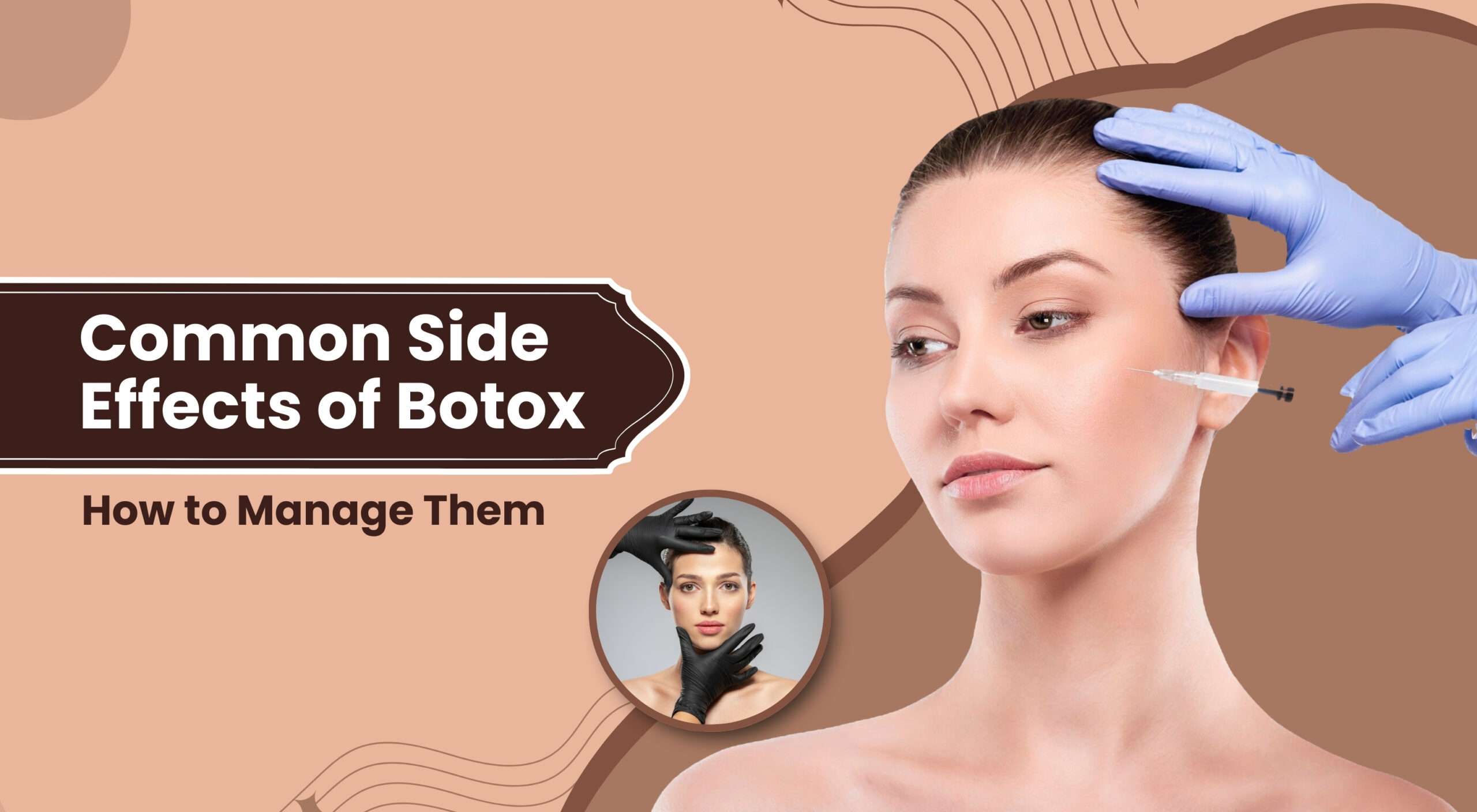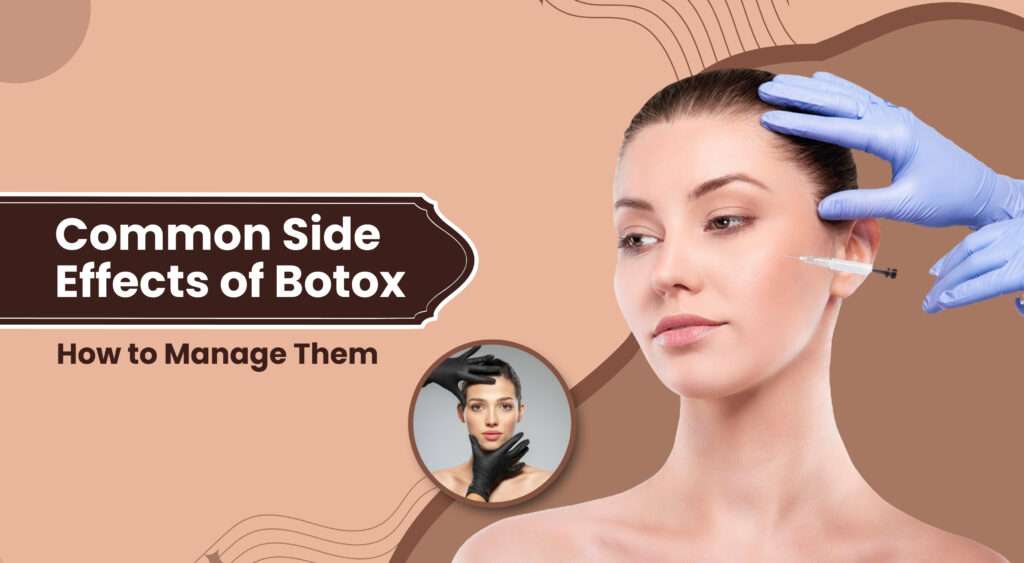
Botox is a cosmetic treatment used to smooth out wrinkles, reduce fine lines, and treat various medical conditions such as migraines and excessive sweating. Like any other procedure, Botox can cause side effects. If one is considering Botox, he or she should be aware of what to anticipate and how to handle possible side effects.
We will discuss the most common Botox side effects, but we will also provide easy tips on how to deal with them. No need to worry we will keep it straightforward.
Pain, Swelling, or Bruising at the Injection Site
What Happens:
Mostly, after injection of Botox, one would find areas where the needles were inserted aching, swollen, or having visible blood spots. This is due to the reaction from the skin and the muscles to the injection.
How to Manage It:
- Apply ice to the area by using an ice pack or a damp cloth and applying it to the skin for some time to reduce swelling.
- Touch and rubbing the injection site should be avoided after treatment is done.
- Bruising can occur, but it fades after a few days. A little bit of makeup is enough to conceal it during that short time.
Headache or Flu-like Symptoms
What Happens:
Some of them even claim to have just the mildest type of headache or flu-like symptoms after Botox. It might be getting your body used to the treatment or the effect of that small needle injection.
How to Manage It:
- Drink plenty of water, as dehydration can worsen headaches.
- Rest for a few hours after your treatment. Sometimes, lying down in a quiet dark room helps.
- Over-the-counter pain relief medications, such as ibuprofen or acetaminophen, may also help to ease the headache. Follow all guidelines and recommendations from your doctor.
Drooping Eyelids or Eyebrows
What Happens:
Botox works by temporarily weakening muscles, the requirement is to relax the muscles causing wrinkles. However, if it spreads to the surrounding muscles, for example around the eyes or eyebrows, then it may weaken those muscles so much that they droop.
How to Manage It:
- Drooping usually resolves itself within a couple of weeks, when the Botox breaks down.
- If this is the case, make sure to return to your physician. He or She may be able to recommend an alternate procedure for future injections to help prevent this from becoming an issue.
- In a few cases, an eye drop may be prescribed along with drooping.
Muscle Weakness or Temporary Paralysis
What Happens:
Botox works by relaxing muscles. Which tends to relax wrinkles but can also temporarily weaken the surrounding muscles. Some people go on complaining of experiencing a “frozen” appearance or loss of control over some facial expressions.
How to Manage It:
- It is transitory, and it may resolve as the Botox is absorbed. Full recovery may take a few weeks.
- When you feel you have some unusual weakness, just inform your doctor, who may modify the dose for the next administration.
- Do not worry; most people become normal again after a brief recovery period.
Allergic Reactions
What Happens:
Some people might develop an allergic reaction to Botox. Symptoms may include itchiness, rash, or even shortness of breath. This is serious, and you should seek medical attention immediately.

How to Manage It:
- If you experience any symptoms of an allergic reaction immediately after the treatment, then contact your doctor immediately.
- It is relatively rare to have reactions to Botox. Thus, it is still highly recommended to talk to your doctor before your treatment to ensure that it is safe for you.
When Should You Contact Your Doctor?
Botox is a relatively safe procedure, if you experience any of the following side effects or just have concerns about how you’re healing, be sure to reach out to a Cosmetic Surgeon. It’s always better to ask questions and get advice from a professional. Remember, most side effects of Botox are mild and temporary.
Conclusion
The reduction of wrinkles and other conditions makes Botox an excellent option. Some of the common side effects include swelling, bruising, or headaches, though they are mild in nature and disappear after some days on their own. One can easily manage all these side effects by following a few simple steps on how to maintain your Botox results longer, which ultimately allows you to enjoy the benefits with confidence.
Always remember to talk with your dermatologist or healthcare provider about Botox, especially if you have a question about the potential side effects. Your dermatologist will then be in the position to advise you about what you can expect about the change.
Related Blogs
Botox Treatment Cost in Delhi
How to Maintain Your Botox Results Longer & Healthier
Common Side Effects of Botox & How to Manage Them
Botox vs. Dermal Fillers: Which is More Effective for Anti-Aging Skin
Major Difference Between Botox and Fillers For Lips
Frequently Asked Questions
No permanent damage to muscle or skin is caused by Botox. These effects are temporary, and once the Botox leaves the body, the normal function of the muscles returns.
Keep in mind: that it is very possible to make the eyebrows droop in the corners, and this is completely avoidable by making sure the injection goes into the appropriate muscles.
Damping usually caused by Botox usually fades within a few weeks and will thereby quickly subside. The quantity is unpredictable, but improvement usually occurs in 2 to 4 weeks.
No, drooping eyelids or eyebrows is not too common among side effects but can happen. This generally occurs if Botox has spread to surrounding muscles that control the eyelid or brows.





